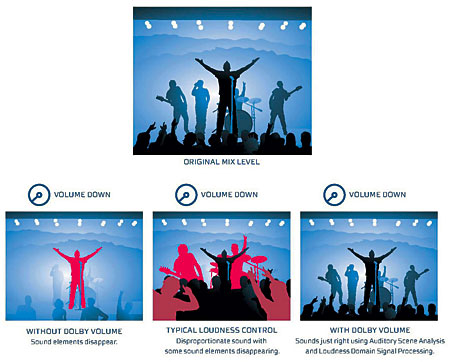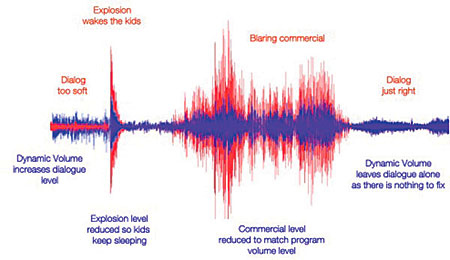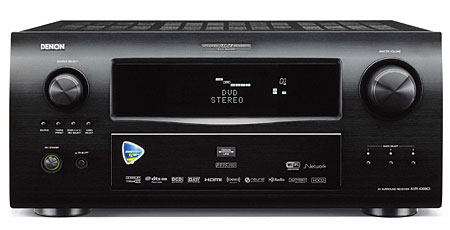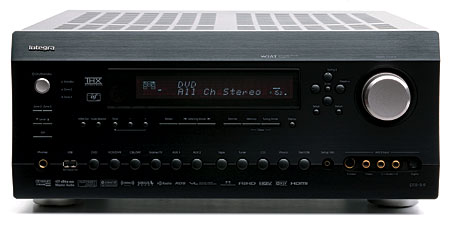Tune In, Turn Down, Turn On! Page 2
Dolby Volume
Dolby Volume analyzes the source in up to 40 frequency bands. Then it reviews each channel independently in a predictive technology that Dolby calls Auditory Scene Analysis. Using these data, together with a psychoacoustical model of human hearing, it compensates for a lowered volume level to produce the same perceived frequency balance you would hear if the volume were cranked to reference level. Dolby calls this equalization process its Volume Modeler.

Dolby Volume also adds variable dynamic range compression and allows the user to control how aggressively it is applied. In Dolby-talk, this is called Volume Leveling, and its intent is to provide a consistent listening experience across all input sources based upon the user’s level setting.
For example, in the new Arcam FMJ AVR600 A/V receiver, Dolby Volume lets you choose between minimal leveling (a setting of 0) or maximum (a setting of 10). Although the Volume Modeler, on the other hand, is fixed, the Arcam also has a Calibration Offset control that can adjust the compensation baseline to take the speakers and room into consideration.
Dolby Volume performs independent loudness adjustments to different frequency bands and channels to maximize the system’s effectiveness while avoiding processing artifacts.
Audyssey Dynamic EQ and Dynamic Volume
Audyssey’s solution employs filters that analyze hundreds of points in the audible frequency range—or, in higher-end implementations, up to thousands. The process begins with Audyssey’s MultEQ room equalization. After the MultEQ calibration process is complete, Dynamic EQ can be engaged. Audyssey designed the latter to maintain the octave-to-octave tonal balance at lower playback levels. It also adjusts the level of the surround channels to maintain the same surround envelopment experience you would hear at reference level.

When Dynamic Volume is added to MultEQ and Dynamic EQ, the full Audyssey processing chain works together to make whatever adjustments are needed to keep a relatively constant listening level. It also adjusts for proper tonal and channel balance across different program sources at all playback levels. To maintain good dialogue intelligibility, Dynamic Volume uses what its algorithm determines as the average dialogue level as a baseline.

It’s worth noting that the new Onkyo and Integra A/V receivers and surround processors are the first devices we’ve tested that offer all three of these Audyssey features. They include two Dynamic Volume settings, Light and Heavy. Audyssey Dynamic Volume cannot be engaged without also engaging Audyssey’s MultEQ and Dynamic EQ. However, you can use the latter two to provide reduced-level tonal compensation without Dynamic Volume’s volume-leveling capability.
Taking It All In
The features of these three technologies overlap to a degree. They’re all designed to compensate for the losses in audible frequency response as the playback level is reduced. They just use different approaches to get there. Dolby Volume and Audyssey Dynamic Volume also offer dynamic range compression to reduce the level difference between the quietest and loudest passages.

Dolby Volume and THX Loudness Plus can both be used with any equalization that’s built into an A/V receiver or surround processor (including Audyssey’s MultEQ). THX Loudness Plus is generally positioned after the equalization in the processing chain, Dolby Volume before. Which of these arrangements works better, if either, is a question we can answer only after experience with a wider range of products that are equipped with these features. The Audyssey scheme works together with its own equalization system, for a closer integration between the two technologies: equalization and level compensation. Although Dynamic Volume is technically a standalone technology, in every consumer product we’re aware of it’s implemented in such a way that you can only use it in conjunction with Audyssey MultEQ.
We haven’t had the opportunity for a hands-on evaluation of Dolby Volume, but we hope to in the near future. However, we did review the Integra DTR-9.9 A/V receiver (Home Theater, April 2009), which offers both the full suite of Audyssey features and THX Loudness Plus.
THX Loudness Plus, with Integra’s Audyssey MultEQ switched on (you cannot use Audyssey Dynamic Volume and/or Dynamic EQ together with THX Loudness Plus) did spruce up the response at the listening level I chose for testing (about 20 dB below ref-erence). But the effect was relatively subtle on most program material.

On the other hand, the full set of Audyssey enhancements appeared to retain a bit more bass at the bottom and air at the top at the same level. But without a precise level match (which is difficult to get with a constantly changing source and technologies that are designed to perform similar functions but with different algorithms), it’s not possible to be definitive about this. The results will also vary based on the program material, the room, and how much the listener’s hearing varies from the hearing models used in each system’s design.
It came as no surprise that neither of the two technologies I auditioned could equal the visceral thrill of peak program levels at 5 to 10 dB below reference. But I certainly agree that any of these systems is potentially more useful than a lot of the bells and whistles in today’s home theater gear. This is particularly the case if, by preference or necessity, most of your listening is at reduced playback levels.

























































